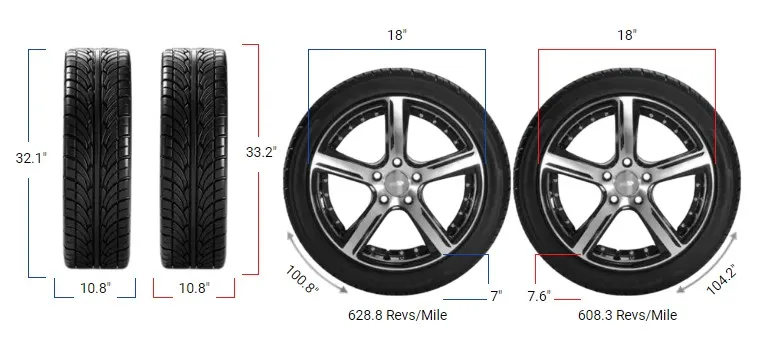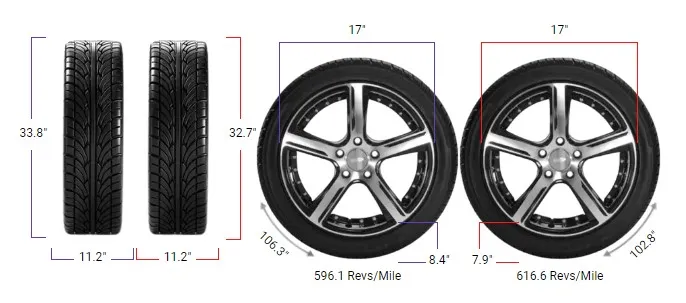Tire Size 205/75r15 vs 215/75r15

Thinking about swapping your 205/75r15 tires for 215/75r15 ones? Let’s break down what this change means for your ride.
- Wider tires provide better traction and road grip.
- Increased tire size offers slightly higher ground clearance.
- The vehicle gains a more robust and appealing look.
- Enhanced ride comfort due to taller sidewalls.
- Fuel efficiency may decrease slightly with wider tires.

Fitment Guide
Replacement tires must be within plus or minus 3% of the original tire’s overall diameter. If the diameter difference exceeds this acceptable range, then the interchange is not recommended. Exceeding this limit could lead to issues like rubbing or clearance problems.
On-Road Impact
Switching to a different tire size can affect how your vehicle performs on paved roads. Let’s explore how this change might influence your daily driving.

- Ride Comfort: The slightly larger diameter of the 215/75r15 may offer a smoother ride due to the increased sidewall height, which can absorb bumps better. However, the wider width could make steering a bit less responsive, especially in tight turns.
- Gas Mileage: A wider tire like the 215/75r15 increases rolling resistance. This means your engine has to work a bit harder, potentially leading to a slight decrease in fuel efficiency. The difference is minimal but worth considering if fuel economy is a priority.
- Speedometer Accuracy: The larger circumference means your speedometer may read slightly lower than your actual speed. The difference is about 2.2%, so when your speedometer reads 60 mph, you’re actually going about 61.3 mph.
- Durability & Wear: The 215/75r15‘s wider footprint can distribute the vehicle’s weight more evenly across the tire surface. This might lead to more even tread wear over time, potentially extending the tire’s lifespan.
- Aesthetics Look: If you’re after a more robust appearance, the wider and taller 215/75r15 tires can give your vehicle a beefier look. This can enhance the visual appeal, especially on trucks and SUVs.
- Braking Performance: A wider tire can improve braking performance because of the increased contact patch with the road surface. This can lead to shorter stopping distances in some conditions, enhancing safety.
- Noise Level: Wider tires sometimes generate more road noise due to the larger surface area in contact with the pavement. This could slightly increase cabin noise at higher speeds, which might affect driving comfort for some.
- Handling and Stability: The increased width can enhance stability, especially during cornering. This can provide a more confident feel when driving on highways or curvy roads, though the difference may be subtle.
Off-Road Impact
For those who take their vehicles off the beaten path, tire size changes can have significant effects. Here’s what to expect off-road.

- Ground Clearance: The slightly taller 215/75r15 tires provide a marginal increase in ground clearance—about 0.3 inches (7.5 mm) more sidewall height. This can be beneficial when navigating over rocks, roots, and uneven terrain.
- Traction: The wider tire may offer better traction in off-road conditions due to a larger contact area with the ground. This can improve grip on loose surfaces like sand or mud.
- Rubbing Issues: The increased size might cause the tires to rub against the wheel wells or suspension components if the vehicle isn’t designed for larger tires. This is especially important in off-road scenarios where the suspension is fully compressed.
- Handling: The changes in tire size can affect steering and handling characteristics. Off-road, this might mean a slight difference in how the vehicle responds to steering inputs, which can be negligible for most drivers.
- Suspension Stress: Larger tires can put additional stress on suspension components. Over time, this could lead to increased wear, especially if the vehicle is frequently used in demanding off-road conditions.
- Fuel Efficiency Off-Road: While fuel efficiency is generally lower off-road due to the demanding conditions, the wider tires might slightly increase fuel consumption because of the added rolling resistance. This could mean carrying extra fuel on longer trips.
- Mud and Snow Performance: The wider 215/75r15 tire can “float” more on top of soft surfaces like mud or snow. This can be beneficial in preventing the vehicle from sinking but might reduce the ability to cut through to firmer ground beneath.
- Vehicle Load: The increased tire size can slightly alter the vehicle’s load capacity. While the change is usually negligible, it’s something to consider if you’re carrying heavy gear or towing.
205/75r15 vs 215/75r15
| Feature | 205/75R15 | 215/75R15 | Difference |
|---|---|---|---|
| Diameter inches (mm) | 27.11 (688.5) | 27.7 (703.5) | +0.59 (+15) +2.2% |
| Width inches (mm) | 8.07 (205) | 8.46 (215) | +0.39 (+10) +4.9% |
| Circumference inches (mm) | 85.16 (2162.99) | 87.01 (2210.11) | +1.86 (+47.12) +2.2% |
| Sidewall Height inches (mm) | 6.05 (153.75) | 6.35 (161.25) | +0.30 (+7.5) +4.9% |
| Revolutions per mile (km) | 744.04 (462.32) | 728.17 (452.47) | -15.86 (-9.86) -2.1% |
| Speedo Reading | 20 mph (32.19 km/h) | 20.44 mph (32.89 km/h) | +0.44 mph (+0.70 km/h) |
Difference Between 205/75r15 and 215/75r15
The main difference between 205/75r15 and 215/75r15 tires lies in their width and overall diameter. The 215/75r15 tire is 10 mm wider and has a slightly larger diameter by 15 mm.
This affects aspects like traction, ground clearance, and handling characteristics of the vehicle.
Can I Use 215/75r15 Instead of 205/75r15?
Yes, you can use 215/75r15 tires instead of 205/75r15. The diameter difference is 2.2%, which falls within the acceptable range of up to 3%.
This means the swap should not cause significant issues with fitment, speedometer accuracy, or vehicle performance.
How Much Taller Is a 215/75r15 Tire Than a 205/75r15?
A 215/75r15 tire is approximately 0.59 inches (15 mm) taller than a 205/75r15 tire. This results in a 2.2% increase in overall diameter, which slightly raises the vehicle’s ground clearance without major impact on driving dynamics.
How Much Wider Is a 215/75r15 Tire Than a 205/75r15?
The 215/75r15 tire is about 0.39 inches (10 mm) wider than the 205/75r15 tire. This represents a 4.9% increase in width, offering better road grip and stability but may slightly affect fuel efficiency due to increased rolling resistance.
Our Observation
Switching from 205/75r15 to 215/75r15 tires comes with both advantages and drawbacks. On the positive side, the wider and slightly taller 215/75r15 tires can enhance your vehicle’s aesthetic appeal and may improve off-road traction and ground clearance.
The increased sidewall height might also contribute to a smoother ride on rough surfaces. On-road, you might notice improved stability and braking performance due to the larger contact area.
However, these benefits are relatively minor due to the small size difference. Potential drawbacks include a slight decrease in fuel efficiency and possible speedometer inaccuracies, although these are minimal.
There’s also a risk of the new tires rubbing against the wheel wells, especially if your vehicle has limited clearance. Additional stress on suspension components and slightly increased road noise are other considerations.
Overall, the differences are small and may be negligible for many drivers. If your vehicle can accommodate the slightly larger size without exceeding the 3% diameter variance, and you desire the minor benefits, the switch could be worthwhile. Always consult with a tire professional to ensure compatibility with your specific vehicle model.



